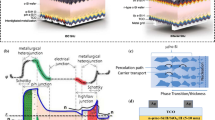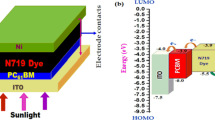Abstract
The work is devoted to the optimization of layer thickness in an organic photovoltaic cell. It presents the applied calculation method which is based on the optical transfer matrix 2×2 formalism. We present the influence of thickness of a PEDOT:PSS layer and of an active layer on the normalized modulus squared of optical electric fields distribution inside devices and on the distributions of exciton generation rate. We present the relationship between optimal thicknesses of the PEDOT:PSS layer and the active layer. We also present the influence of antireflection coating on distributions of optical electrical fields, as well as the distributions of exciton generation rate. Perpendicular and oblique illumination of the photovoltaic structure is discussed.
Similar content being viewed by others
References
L. Fraas and L. Partain, Solar Cells and Their Applications, John Wiley & Sons, Inc., Publication, New Jersey, 2010.
B. Parida, S. Iniyanb, and R. Goic, “A review of solar photovoltaic technologies”, Renew Sust. Energ. Rev. 15, 1625–1636 (2011).
E. Gondek, I.V. Kityk, and A. Danel, “Photovoltaic effect in single layer 1H-pyrazolo3,4-b]quinoline and 1H-pyrazolo3,4—b]quioxaline/poly(3-decylthiophene) polymer cellsbold”bold, Z Naturforschung A64, 632–638 (2009).
E. Gondek, Y. Djaoued, J. Robichaud, P. Karasiński, I.V. Kityk, A. Danel, and K.J. Plucinski, “Influence of TiO2 nanoparticles on the photovoltaic efficiency of the ITO/ PEDOT: PSS/fluorine copolymers/polythiophene:TiO2/Al architecture”, J. Mater. Sci-Mater El. 23, 2057–2064 (2012).
A. Pivrikas, H. Neugebauer, and N.S. Sariciftci, “Influence of processing additives to nano-morphology and efficiency of bulk-heterojunction solar cells: A comparative review”, Sol. Energy 85, 1226–1237 (2011).
G. Kalita, M. Masahiro, W. Polchi, and M. Umeno, Solid—State Electronics 54, 447–451 (2010)
J. Alstrup, M. J_rgensen, A.J. Medford, and F.C. Krebs, “Ultrafast and parsimonious material screening for polymer solar cells Rusing differentially pumped slot-die coating”, Appl. Materials & Interfaces 2, 2819–2827 (2010).
H. Hoppe and N.S. Sariciftci, “Organic solar cells: An over-view”, J. Mater. Res. 19, 1924–1945 (2004)
P. Peumans, A. Yakimov, and S.R. Forrest, “Small molecular weight organic thin-film photodetectors and solar cells”, J. Appl. Phys. 93, 3693–3723 (2003).
B.R. Saunders and M.L. Turner, “Nanoparticle-polymer photovoltaic cells”, Advances in Colloid and Interface Science 138, 1–23 (2008).
G. Li, L. Liu, F. Wei, S. Xia, and X. Qian, “Recent progress in modelling, simulation, and optimization of polymer solar cells”, IEEE J. Photovoltaics 2, 320–340 (2012).
L.A.A. Pettersson, L.S. Roman, and O. Inganäs, “Modelling photocurrent action spectra of photovoltaics based on organic thin films”, J. Appl. Phys. 86, 487–496 (1999).
R. Häusermann, E. Knapp, M. Moos, N.A. Reinke, T. Flatz, and B. Ruhstaller, “Coupled optoelectronic simulation of organic bulk-heterojunction solar cells: parameter extraction and sensitivity analysis”, J. Appl. Phys. 106, 104507 (2009).
A. Meyer and H. Ade, “The effect of angle of incidence on the optical field distribution within thin film organic solar cells”, J. Appl. Phys. 106, 113101 (2009).
S. Jung, K.Y. Kim, Y.I. Lee, J.H. Youn, H.T. Moon, J. Jang, and J. Kim, “Optical modelling and analysis of organic solar cells with coherent multilayers and incoherent glass substrate using generalized transfer matrix method”, Jpn. J. Appl. Phys. 50, 122301–1 (2011).
G. Li, L. Liu, F. Wei, S. Xia, and X. Qian, “Recent progress in modelling, simulation, and optimization of polymer solar cells”, IEEE J. Photovoltaics 2, 320–340 (2012).
E. Gondek, “Influence of substrate refractive index and anti-reflection coating on excitons generation in organic solar cell”, submitted to Opt. Quant. Electron. 46, 221–227 (2014).
J. Chandrasekaran, D. Nithyaprakash, K.B. Ajjan, S. Maruthamuthu, D. Manoharan, and S. Kumar, “Hybrid solar cell based on blending of organic and inorganic materials — An overview”, Renew. Sust. Energ. Rev. 15, 1228–1238 (2011).
P. Karasiński, J. Jaglarz, M. Reben, E. Skoczek, and J. Mazur, “Porous silica xerogel films as antireflective coatings. Fabrication and characterization”, Opt. Mater. 33, 1989–1994 (2011).
E. Skoczek, J. Jaglarz, P. Karasiński, “Ellipsometric and spectrophotometric investigations of porous silica thin films produced by sol-gel method”, Acta Phys. Pol. A120, 732–735 (2011).
B.E. Seleh and M.C. Teich, Fundamentals of Photonics, Wiley, New York, 1991 ch.10.1B.
S. Laux, N. Kaiser, A. Zöller, R. Götzelmann, H. Lauth, and H. Bernitzki, “Room-temperature deposition of Indium Tin oxide thin films with plasma ion-assisted evaporation”, Thin Solid Films 335, 1–5 (1998).
D. Zhu, W. Shen, H. Ye, X. Liu, and H. Zhen, “Determination of the optical constants of polymer light-emitting diode films from single reflection measurements”, J. Phys. D: Appl. Phys. 41, 235104 (5pp) (2008).
E.D. Palik, Handbook of Optical Constants of Solids, Vol.1, Table XII Academic Press, New York, 1998.
P. Yeh, Optical Waves in Layered Media, John Wiley & Sons, New York, 1988.
H.A. Haus, Waves and Fields in Optoelectronics, Prentice- -Hall, Inc. New Jersey, 1984
P. Karasiński, “Application of 4×4 matrix method for the modelling of planar waveguide sensors”, Proc. SPIE 4239, 229–234 (2000).
P. Karasiński, “Sensor properties of planar waveguide structures with grating couplers”, Opto-Electron. Rev. 15, 168–178 (2007).
P. Karasiński, “Optical uniform/gradient waveguide sensor structure — characterization”, Opto-Electron. Rev. 19, 1–9 (2011).
E. Gondek and P. Karasiński, “One-dimensional photonic crystals as selective back reflectors”, Opt. Laser Technol. 48, 438–466 (2013).
E. Gondek, “Optical optimization of organic solar cells”, Opt. Mater., 36, 98–101 (2013).
S. van Bavel, E. Sourty, G. de With, K. Frolic, and J. Loos, “Relation between photoactive layer thickness, 3D morphology, and device performance in P3HT/PCBM bulk-heterojunction solar cells”, Macromolecules 42, 7396–7403 (2009).
Author information
Authors and Affiliations
Corresponding author
About this article
Cite this article
Gondek, E. Optical optimization of organic solar cell with bulk heterojunction. Opto-Electron. Rev. 22, 77–85 (2014). https://doi.org/10.2478/s11772-014-0180-4
Published:
Issue Date:
DOI: https://doi.org/10.2478/s11772-014-0180-4




